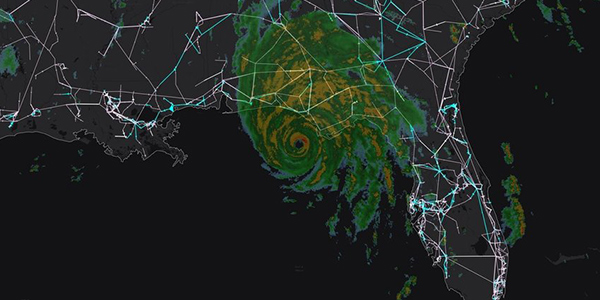By Rich Heidorn Jr.
NERC will begin testing the newest version of its situational awareness tool in mid-November, which will add the ability to integrate transmission feeds with other sources such as real-time weather station data and radar.
Situational Awareness for FERC, NERC and the Regional Entities (SAFNR v.3) was piloted in 2017 during GridEx IV. It is being developed by ResilientGrid, an Austin, Texas, firm headed by Michael Legatt, who holds doctorates in both energy systems engineering and clinical health psychology/neuropsychology.
That unusual pairing of disciplines helps explain the idea behind SAFNR v.3, he told NERC’s Operating Reliability Subcommittee on Sept. 4.
“At a high level, the philosophy that drives the work we do and the tools we build are that the most important components on the grid are now — and will always be — human beings in the control room and the field,” he said.
“Under high-stress situations, when people collaborate — especially from adjacent infrastructures or different control rooms — if they’re looking at different pictures, the likelihood of human error goes up pretty significantly, especially under the times of the most profound stress. So, this tool is part of a larger platform and our vision to support shared situational awareness and collaboration throughout the industry.
“Situational awareness requires two things that the human brain cannot do at the same time: scanning and focusing. Often you have loss of situational awareness when people are focused on one thing and tend to … miss either a threat or opportunity” while attempting to also scan, Legatt said.
“Things that you’ll often find in control rooms — from the NERC and [Information Sharing and Analysis Center] level to the [reliability coordinators] down to the [transmission operators] and [distribution service providers] — all of these entities tend to have lots of different screens and monitors, and operators will look back and forth. But when you integrate [the sources] together, you start to see the impacts of these relationships. … By building a common integrated view, we’re able to significantly increase the effectiveness and speed of collaboration and reduce some risks of human error.”
The system was piloted with FERC, NERC and the Electricity Information Sharing and Analysis Center (E-ISAC) and used by E-ISAC and NERC Bulk Power System Awareness operators to track the progress of GridEx IV in 2017.
Exercising what he called “continuous improvement,” Legatt said his company plans to upgrade the system regularly. “The most important thing we build is really the relationship with the industry,” he said.
For example, he said GridEx led NERC and the E-ISAC to streamline their data entry for electric emergency incident and disturbance reports (Form OE-417) and EOP-004 event reporting forms.
James Merlo, NERC’s director of reliability risk management, said SAFNR v.2 replaced the original “rudimentary” tool in 2010. “It’s nine- or 10-year-old technology. It’s time to be re-platformed,” he said.
Merlo said the system will be based on raw Inter-Control Center Communications Protocol power flow data from RCs. That data can be overlaid with other data sources such as fires and weather.
“You can actually look at forest fires, transpose that with which way the wind is blowing and then … be a little more predictive to say: that fire is threatening that transmission line. It allows us to see all that without having to call individual entities.
“All of that data was available. You could turn this map on, and you could turn [that] map on, so you had to look at them all individually. This is now a holistic platform that allows you to create those layers so you can clutter or declutter as necessary to create situational awareness.”





